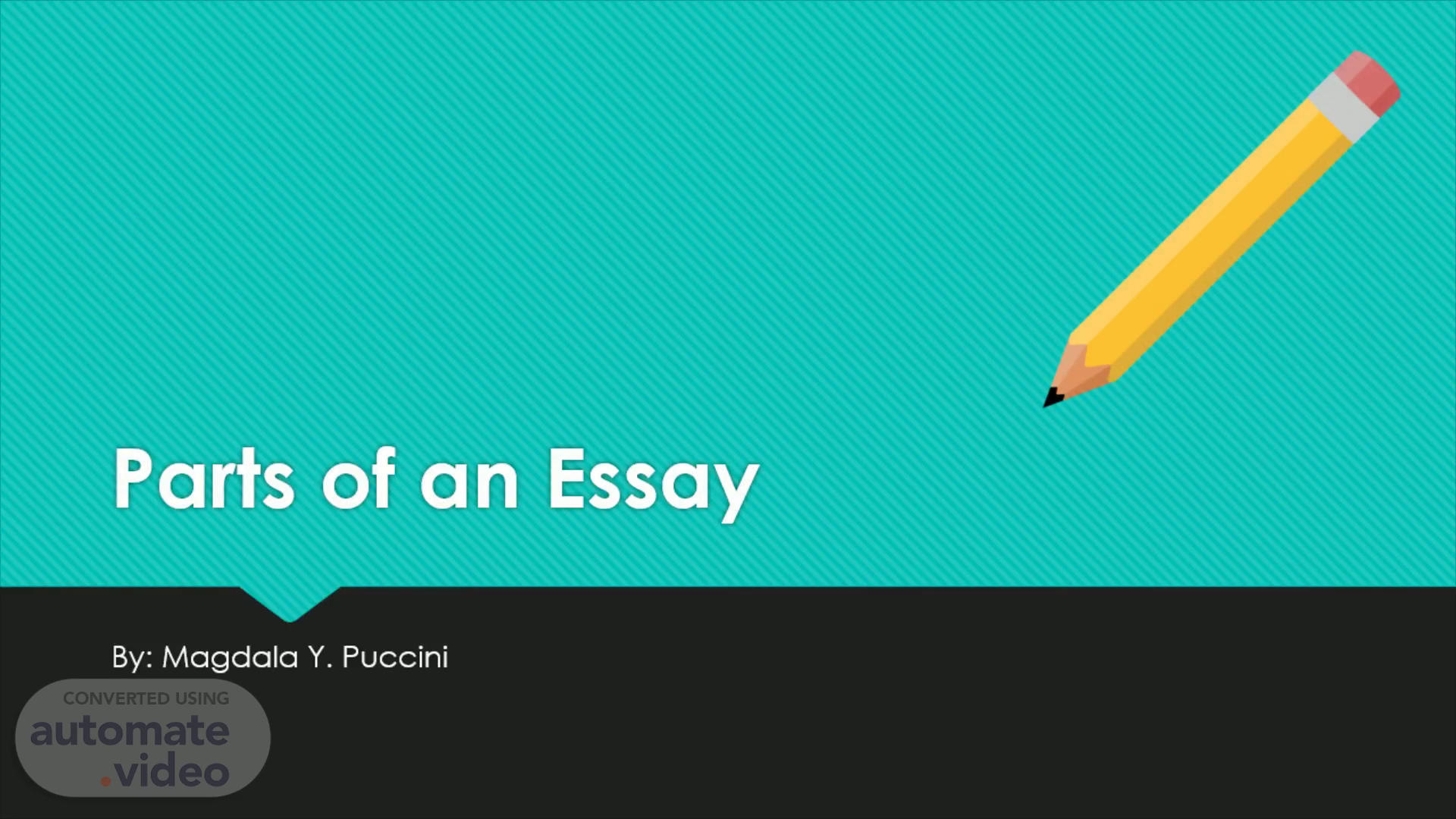Scene 1 (0s)
Parts of an Essay. By: Magdala Y. Puccini.
Scene 2 (7s)
What is the purpose of a good essay?. An essay is defined as a piece of writing that is typically written to convince someone of something or to simply inform the reader about a particular topic. In order for the reader to be convinced or adequately informed, the essay must include several important components to make it flow in a logical way. The main parts of an essay are the intro, body, and conclusion. In a standard short essay, five paragraphs are usually enough to provide the reader with enough information in a short amount of space. On the other hand for a research paper or dissertation, it is important that more than five paragraphs are present in order not to overwhelm the reader with too much information in just one paragraph (Evansville, n.d.)..
Scene 3 (41s)
The Process of Writing an Essay. The process of writing an essay is composed of three main stages: Preparation: choose your topic, do your research, and develop an essay outline. Writing: establish your argument in the introduction paragraph, develop and support it with evidence in the body paragraphs, and then sum it up with a conclusion. Revision: double check the content, organization, grammar, spelling, as well as the formatting of your writing before submission..
Scene 4 (1m 6s)
Main Parts of an Essay. INTRODUCTION (Part 1) Introduces the topic, includes an opening hook, as well as a thesis statement. BODY (Part 2-4) Supports the thesis statement, includes examples and begin with topic sentences. Body Paragraph 1 : Includes your strongest argument. CONCLUSION (Part 5) Sums up the essay and restates the thesis statement in a different way. Body Paragraph 2 : Covers the second strongers argument. Body Paragraph 3 : Presents the weakest argument..
Scene 5 (1m 28s)
Introduction Paragraph. Must have a hook, also known as an attention grabber for your audience. It should make your essay sound interesting and could even be a quote or fact related to your topic. Ensure that the introduction paragraph works from general to specific information in regards to the topic. Provides the reader with a kind of guide of your essay in a logical order. At the end of the introduction paragraph there should be a thesis statement. The thesis statement expresses the aim of the essay and may provide insight into the writer’s examples and evidence..
Scene 6 (1m 55s)
Body Paragraphs. The body paragraphs should include the support and evidence of the essay as well as the writer’s ideas. Each body paragraph must include a topic sentence which relates the discussion back to the thesis statement in the introduction paragraph. Must include the logical ordering of ideas (3 types of order). 1. Chronological order: order of time which is good for naratives. 2. Spatial order: good for descriptions such as locations, top to bottom, ect. 3. Emphatic Order: least to most important and is very common in college writing..
Scene 7 (2m 22s)
Conclusion Paragraph. The conclusion paragraph should basically sum up all of your points and arguments. It should reiterate the main arguments in a clear and consise way. Ensure that your audience is left with something to think about, especially it is an argumentative essay..
Scene 8 (2m 38s)
Writing Terms to Remember:. Abstract- refers to a brief summary of an article, and is a standard part of most academic writing. Attribution- refers to g iving credit for a quote, illustration, or other element to its source. Audience- refers to the intended reader or readers. Citation- refers to referencing the source of information. Draft- refers to the complete unedited version of a piece of writing. Edit- to read and make revisions of a draft for grammar, flow, length or any other factor required to make it a stronger piece of work..
Scene 9 (3m 3s)
Writing Terms to Remember (continued). Format- is the layout aspects of a piece of writing which includes spacing, margins, indentations and font. Hook- is a line that draws the reader’s attention to the piece of writing in the introduction. Plagarism - refers to the unauthorized use of another person’s words. Proofreading - refers to c hecking for technical errors in the writing. When proofreading, we are look for spelling, punctuation, capitalization, grammar and related items, not for style or structure. Thesis Statement- refers to th e key argument the writer put forward in the introduction, and is usually in the last line of the introduction paragraph..
Scene 10 (3m 32s)
Important Tips:. Make sure to use transitional sentences to create a good flow to the essay. Ensure to include substancial evidence and examples that support your argument and cite your sources. Make sure all examples are relevant to the topic. Allow time to re-write your first draft and allow time to proofread your final draft before sumbission. Ensure to cite all sources properly to avoid any plagarism!.
Scene 11 (3m 53s)
References. Your Dictionary. (n.d.). What are the main parts of an essay? https://grammar.yourdictionary.com/writing/what-are-the-main-parts-of-an-essay.html Evansville. (n.d.). Components of a Good Essay. https://www.evansville.edu/writingcenter/downloads/parts.pdf Scribbr. (n.d.). How to Write an Essay. https://www.scribbr.com/category/academic-essay/.
